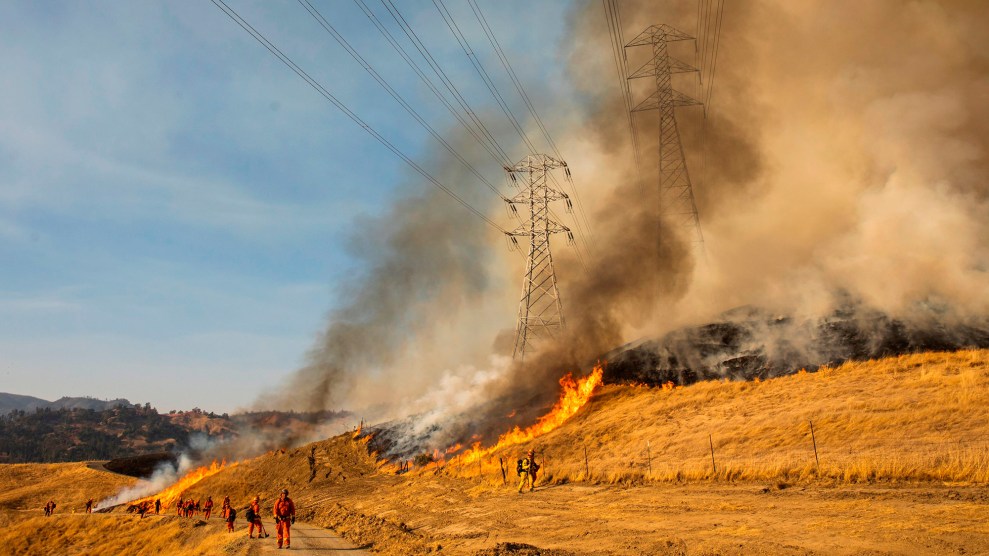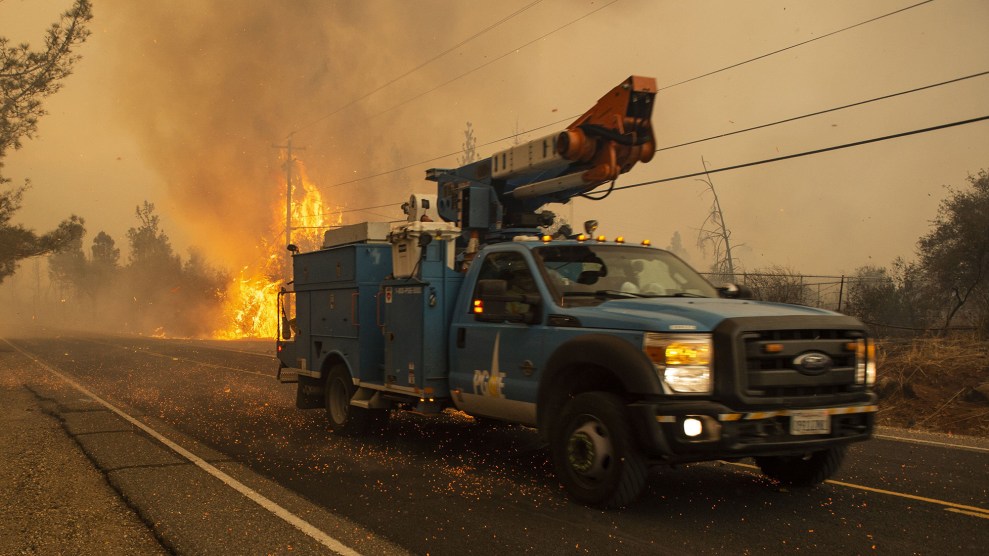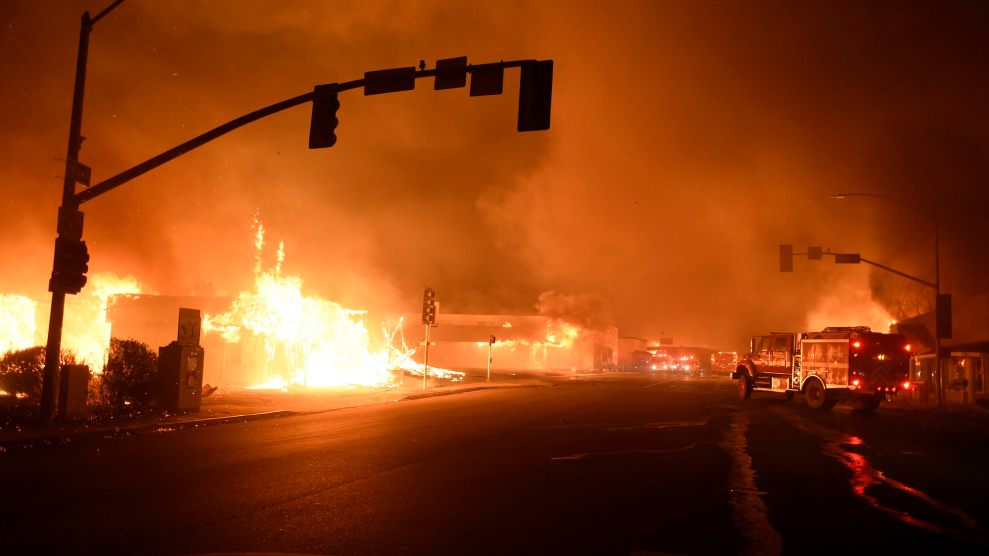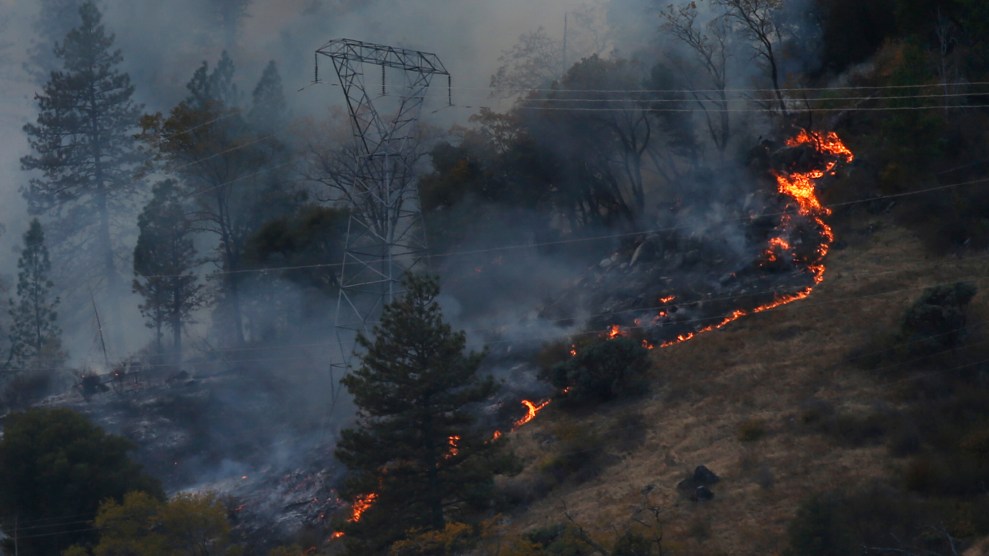
Firefighters battle the Kincade Fire in Healdsburg in October 2019.Philip Pacheco/AFP via Getty Images
As California finally takes control of the fires that have been burning for weeks, PG&E is—and will continue to be—in the hot seat. It seems likely that transmission equipment from the utility, which supplies power for roughly 40 percent of Californians, sparked the recent Kincade fire, a blaze that pushed over 180,000 people from their homes in and near Sonoma County, destroyed 374 structures, and burned almost 78,000 acres. As many as 16 fires burned across the state over the past several weeks, and at the same time PG&E was intermittently cutting power to millions of people—a practice the company’s CEO predicts will continue for another decade. Gov. Gavin Newsom declared a state of emergency and hasn’t been shy about calling out the company for it’s mismanagement and incompetence.
This has put PG&E, which filed for bankruptcy in January over its role in other recent wildfires, in the crosshairs of just about everyone—customers and legislators, as well as the governor—and state officials are looking desperately for a savior to rescue the crumbling grid and the flailing utility.
But right now, it’s really difficult to foresee what the future holds for PG&E—and more broadly for energy across California. Newsom has hinted the government, if it’s not satisfied with the pace of bankruptcy proceedings, could step in and try to take control of PG&E, but he also recently called on Warren Buffet’s Berkshire Hathaway to make a bid for the company. (Berkshire Hathaway’s energy subsidiary is deeply invested in utility companies and renewables in California and several other states.) The governor has also been open to the idea of municipalities taking over their own power management, which some of the cities themselves have echoed. At the same time, in ongoing bankruptcy proceedings, PG&E’s shareholders are fighting its bondholders, who’ve formed an alliance with fire victims, for control.
I recently called up John Geesman, an energy consultant and attorney who served as the executive director of the California Energy Commission, the state’s primary energy policy and planning agency, to try to figure out what is going on and who would even want to take on this mess. We talked about the different stakeholders involved, who might end up in charge of local power, and what the maneuverings will mean for the utility’s millions of customers. “This is a case of first impression,” he says. “The future is going to have to be invented here and invented pretty quickly.”
When we spoke last week, Geesman’s home had been without power since the weekend before, so he was staying up in the Sierras where electricity, run by a public utility district, was still flowing. Regardless of who takes over PG&E, the transition will be “extremely challenging,” he says. “Customers are going to end up paying under any scenario.”
A new era of private ownership
Many have been skeptical of Newsom’s call for Berkshire Hathaway to step in and take over PG&E, which would essentially replace one form of private ownership for another. “It feels a bit like longing for a savior when there isn’t an obvious solution or a cheap solution,” bankruptcy law expert Jared Ellias told the Sacramento Bee. “There isn’t a white knight.” But Geesman thinks it might be less about a white knight and more about upping the competition. “What the governor was emphasizing was the desire to get as many bidders as possible,” he says. Plus, Berkshire Hathaway does have energy expertise with a bent toward renewables, and Warren Buffet has managed to keep a good reputation, which is more than PG&E can say. (Well aware of their fall from grace, PG&E preemptively bought up domain names like pgecrooks.com and pgefailure.com when it filed for bankruptcy.)
While Buffet hasn’t yet indicated any interest in getting involved, PG&E’s bondholders have been looking to wrest control of the company since it went into bankruptcy. As Geesman notes, unlike the shareholders—who have a competing reorganization plan—or an outside group like Berkshire Hathaway, the bondholder group, made up of hedge funds, doesn’t have energy operation experience. (Fire victims are supporting the bondholder plan, which would pay out billions more in compensation.)
But it’s not even certain any of these groups will want to take over anymore. The bondholders’ proposal has a clause allowing them to back out if PG&E is found liable for major damages in a new wildfire. PG&E shares have tanked by roughly 70 percent in 2019, dipping below $4 per share last week, so it is understandable that entities might be scared off. (The shareholder’s bid has a similar clause, and the same logic applies.) In January, courts will begin determining wildfire damages and PG&E’s culpability for the Tubbs fire that ravaged parts of Northern California in 2017.
Still, Geesman doubts either the bondholders or shareholders will drop their bids. “The franchise as it exists today has enormous earning power and that’s what’s attracted the different wolf packs of speculative investors,” he says. “If PG&E has been vilified for the last several years for mismanagement, it’s pretty easy to hypothesize from your office on Wall Street that you could just hire better managers and potentially slice and dice that $20 billion revenue stream in such a way that it makes for a very good investment. Wolves have an innate ability to sense protein. There’s a lot of potential revenue protein in a utility franchise.”
Whoever ends up in charge of PG&E, it’s important to remember that the utility giant didn’t hit rock bottom on its own—and, accordingly, a better future system will almost certainly need more than new ownership. People have long criticized PG&E’s uncomfortably close ties with former Gov. Jerry Brown’s administration and the revolving door between the California Public Utilities Commission and the utilities it regulates. PG&E has spent over $31 million on lobbying in California since 2001, over $8 million of which was spent in 2018. “The regulatory model holds a fair amount of blame” for the current situation, Geesman says. But, “I don’t think this is a problem where you can rationalize, ‘Well, I’ll just appoint better people.’ You really need to focus more on changing that system rather than the individuals responsible for administering it.”
Regulators have failed to hold PG&E accountable in many instances. For example, utilities can use funds from the PUC for certain needs like maintaining equipment, but once they have the money, “very rarely does the commission actually attach strings to that money,” Wall Street Journal energy reporter Rebecca Smith explained on KALW’s “Your Call.” “I think this has allowed the company to do whatever it wanted.” Neglecting to adequately spend on maintenance and equipment over time is one of the biggest criticisms leveled against PG&E. It’s unclear if that kind of (or lack of) oversight would push another company to behave better.
A public takeover
As frustration mounts, more and more people, including presidential hopeful Sen. Bernie Sanders (I-Vt.), seem to believe that the most effective way forward is via municipal control. “It is time to begin thinking about public ownership of major utilities,” Sanders said recently. “The people of California are suffering because of the greed and corruption of utility corporations and their executives.”
But “public ownership” could mean a lot of different things. San Francisco, for instance, offered to buy PG&E’s local power lines for $2.5 billion in September. PG&E rejected its bid in October, but under the proposal, San Francisco would’ve controlled the electrical equipment within the city, allowing it freedom to pick a non-PG&E power supplier. And in San Jose, California’s third largest city, Mayor Sam Liccardo has proposed turning PG&E into a nonprofit customer-owned cooperative. Different than a government takeover, Liccardo likened the cooperative idea to a credit union. The idea has garnered support from more than two dozen mayors and county supervisors who collectively represent about 5 million residents. “A PG&E that needs to rely on junk bonds to finance its future is not a PG&E that California can rely upon, and we need to move forward with a different approach,” Liccardo told KQED.
There has been success with municipal ownership elsewhere; public power utilities exist in cities and localities in every state besides Hawaii. Geesman argues that over the “last several years, probably extending back to the San Bruno experience nine years ago,” it’s been clear that “accountability is most likely to come at the local level, where maintenance issues and investment issues can be intensely scrutinized as opposed to this model that we’ve perpetuated at least a decade too long.” And as energy expert Steven Weissman recently explained to me, “If you’ve got San Francisco Public Utilities Commission as an elected board, and they screw up, then you answer to the voters…Because you’re a local official, and you live locally, you run into constituents in the street, and you go to meetings and you talk to people. The community-level values that are placed on something like safety and reliability can become much higher priorities.”
At the same time, people in communities across the state have already been trying something slightly different: Community Choice Aggregation (CCA), a set-up where a city or county or a combination of the two take over energy purchasing, but the area utility, like PG&E, continues to handle customer service and maintenance. CCAs can then set different rates and offer more energy options, including 100-percent renewable energy (though at a higher cost). Individual residents and businesses in this scenario can opt out and stick with the investor-owned utility. This gives communities more control over prices and more access to alternative energy sources. Only nine states have passed legislation enabling such setups. Currently, there are 19 CCAs in California, and such programs already serve a little under half of PG&E’s customers. In the San Diego area, where CCAs have grown in popularity, San Diego Gas & Electric is exploring handing over power procurement to CCAs entirely, so that the investor-owned company would only be an energy transmission and distribution business (something the California Community Choice Association wants PG&E to do). Theoretically, if utility companies only have to focus on the wires, they’d do a better job of managing risk.
All these options come with their own drawbacks and complications, though at this grand scale, it’s pretty much new ground. Any solution will be complex and difficult and likely require new legislation, and there is still the possibility of mismanagement. Many public entities, of course, lack experience in the energy business. “You’re not going to have a public takeover tomorrow,” Geesman says. “Those things take an extended amount of time.”
Plus, PG&E has yet to signal any desire to turn over control. But if PG&E is found liable for major fire damage yet again, and the shareholders and bondholders use their “out” clauses to withdraw their bids, “then I think the bankruptcy process probably proceeds quite a bit more rapidly into a liquidation,” Geesman says, which paves the way for quicker municipal takeover. If bankruptcy proceedings don’t produce something Sacramento finds acceptable, that’s when Newsom says he might submit the government’s own proposal to the courts.
A grim reality for customers
Unfortunately, in the end, Californians are likely to suffer no matter what happens. “Customers are going to end up paying under any scenario. You’ve got the existing equity value of PG&E down below the $4 billion level. There’s only so much blood in the stone that can be squeezed out going forward,” Geesman says. “The biggest problem that I would envision is a very difficult transition period. What happens while we’re getting from here to there? Who operates the system, and who bears the cost of that? And the customers are the only people with the resources to pick up the bill at the end of the day, and as a consequence, that’s where your financial liability is likely to end up.”
What’s more, the current grid is outdated and in disrepair, and even San Jose’s Mayor Liccardo admits it’d be costly to revamp: “We’re not delusional about the challenges here,” he told the New York Times.
Inevitably, some residents will suffer more than others, causing major equity issues in the short and long term. The state is already seeing it in the aftermath of PG&E’s deliberate power outages, which are disproportionately affecting low-income and other vulnerable communities. “We’ve had some horrible economic despair triggered in these blackouts,” Geesman notes. “I think there’s going to have to be accounting for it.” In just one example, at least 20 low-income seniors who use walkers or wheelchairs were trapped in their apartment complex in Marin County last week when the elevators stopped working during a two-day blackout. During the first round of power outages, PG&E reports showed that at least 8,500 customer with special energy needs due to medical conditions were affected.
That said, the current fiasco also affords an opportunity for real change. Utilities have historically teamed up to block alternative energy systems like microgrids—local community-operated energy grids that can operate and be controlled autonomously. When all the utilities band together, the barriers to reform can be “insurmountable,” Geesman says. But when alliances are destabilized by a weak link, say, “a bankrupt convicted felon who has killed dozens of people over the last several years and is not somebody anyone affords a great deal of credibility to those are pretty good conditions under which to work change.”

















